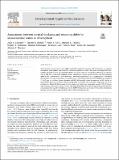Associations between cortical thickness and reasoning differ by socioeconomic status in development
Author(s)
Leonard, Julia Anne; Romeo, Rachel R; Park, Anne T.; Takada, Megumi E.; Robinson, Sydney T.; Grotzinger, Hannah M; Last, Briana S.; Finn, Amy S.; Gabrieli, John D. E.; Mackey, Allyson P.; ... Show more Show less
DownloadPublished version (1.222Mb)
Terms of use
Metadata
Show full item recordAbstract
Although lower socioeconomic status (SES) is generally negatively associated with performance on cognitive assessments, some children from lower-SES backgrounds perform as well as their peers from higher-SES backgrounds. Yet little research has examined whether the neural correlates of individual differences in cognition vary by SES. The current study explored whether relationships between cortical structure and fluid reasoning differ by SES in development. Fluid reasoning, a non-verbal component of IQ, is supported by a distributed frontoparietal network, with evidence for a specific role of rostrolateral prefrontal cortex (RLPFC). In a sample of 115 4–7-year old children, bilateral thickness of RLPFC differentially related to reasoning by SES: thicker bilateral RLPFC positively correlated with reasoning ability in children from lower-SES backgrounds, but not in children from higher-SES backgrounds. Similar results were found in an independent sample of 59 12–16-year old adolescents. Furthermore, young children from lower-SES backgrounds with strong reasoning skills were the only group to show a positive relationship between RLPFC thickness and age. In sum, we found that relationships between cortical thickness and cognition differ by SES during development.
Date issued
2019-04Department
Massachusetts Institute of Technology. Department of Brain and Cognitive SciencesJournal
Developmental Cognitive Neuroscience
Publisher
Elsevier BV
Citation
Leonard, Julia A. et al. "Associations between cortical thickness and reasoning differ by socioeconomic status in development." Developmental Cognitive Neuroscience 36 (April 2019): 100641 © 2019 The Authors
Version: Final published version
ISSN
1878-9293